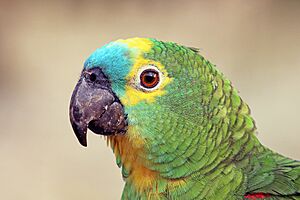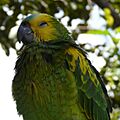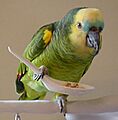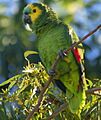Blue-fronted amazon facts for kids
Quick facts for kids Blue-fronted amazon |
|
|---|---|
 |
|
| Wild bird in the Pantanal, Brazil |
|
| Conservation status | |
| Scientific classification | |
| Genus: |
Amazona
|
| Species: |
aestiva
|
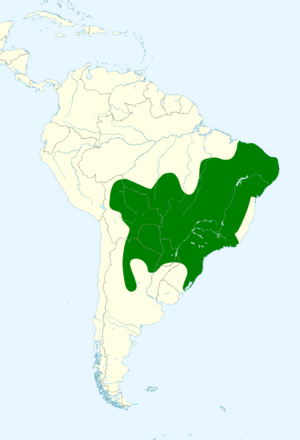 |
|
| Synonyms | |
|
Psittacus aestivus Linnaeus, 1758 |
|
The Blue-fronted Amazon (Amazona aestiva) is a very colorful parrot from South America. People also call it the Blue-fronted Parrot or Turquoise-fronted Amazon. It's one of the most common types of amazon parrots kept as pets. You can easily spot it by the bright blue or turquoise patch of feathers on its head, right above its beak.
Contents
About the Blue-fronted Amazon
The Blue-fronted Amazon is a mostly green parrot. It grows to be about 38 centimeters (15 inches) long. These birds have blue feathers on their forehead and yellow feathers on their face and the top of their head. The amount of blue and yellow can look very different from one bird to another. Unlike many other Amazon parrots, its beak is mostly black.
It's hard for humans to tell male and female Blue-fronted Amazons apart just by looking. But parrots can see colors differently than we do. Using special tools, scientists can see small color differences in their feathers that show if a parrot is male or female. Young parrots are usually not as bright and have dark eyes.
Where Blue-fronted Amazons Live
Blue-fronted Amazons live in several countries in South America. You can find them in eastern and northern Bolivia, eastern Brazil, Paraguay, and northern Argentina. They like to live in forests, woodlands, savannas, and areas with palm trees. However, they usually avoid very wet, dense forests like the Amazon rainforest.
There's also a small group of these parrots living wild in Stuttgart, Germany. These birds are likely pets that escaped and started breeding there. Some have also been seen in Puerto Rico, but they are probably escaped pets too, and haven't started families there.
Blue-fronted Amazon Families
Blue-fronted Amazons build their nests inside holes in trees. The eggs are white and shaped like ovals, about 38 by 30 millimeters (1.5 by 1.2 inches). A female parrot usually lays three to five eggs at a time. She sits on the eggs for about 27 days to keep them warm. After the chicks hatch, they stay in the nest for about 60 days before they are ready to fly out on their own.
Blue-fronted Amazon Subspecies
Scientists recognize two main types, or subspecies, of the Blue-fronted Amazon:
- A. a. aestiva: This type lives in eastern Brazil. The front edge of its wing, near its "shoulder," is red.
- A. a. xanthopteryx: This type is found in northern and eastern Bolivia, parts of Brazil, Paraguay, and northern Argentina. Its "shoulder" is partly or completely yellow. These birds usually have more yellow on their heads than the other type.
Even though these two types look a bit different, they can have babies together where their homes meet. This shows they are very closely related. Also, individual parrots can have different amounts of yellow or red on their faces and "shoulders." Some birds in northwestern Argentina might have almost no yellow on their heads and completely green "shoulders."
Status in the Wild
The Blue-fronted Amazon is considered a species of "least concern" by conservation groups like BirdLife International. This means they are not currently in danger of disappearing. However, their numbers are going down in some areas.
These parrots have been heavily traded as pets. Since 1981, when they were added to a list called CITES Appendix II, over 400,000 wild parrots have been bought and sold internationally. This trade is a big reason why their numbers are dropping. In some places where they live, farmers see them as pests because they eat crops.
Interestingly, sometimes parrots that escape from captivity can help spread the species. For example, the Blue-fronted Amazon is becoming more common in Rio de Janeiro, Brazil, even though it wasn't historically found there. This is likely because escaped pet birds have started new populations.
Blue-fronted Amazons as Pets
Blue-fronted Amazons are very popular pets in South America and around the world. Their ability to talk can be very different from one bird to another. Some can speak almost as well as other famous talking parrots like the Yellow-headed Amazon. They also seem to love singing!
These birds need a lot of attention from their owners. They also enjoy playing with toys for many hours. If you have one as a pet, make sure it has lots of toys, places to sit (perches), and room to climb. It's very important that Blue-fronted Amazons, like some other birds, never eat avocado, as it is poisonous to them. During spring, which is mating season, some of these parrots, especially males, can become a bit more aggressive.
There's a very rare type of Blue-fronted Amazon called a "red" or "chocolate raspberry" mutation. This special bird first appeared in captivity in 2004. In these birds, the yellow feathers are replaced by red or pink, and the green feathers become a chocolate-brown color. The brightness of these colors can vary on different parts of their body.
Images for kids



